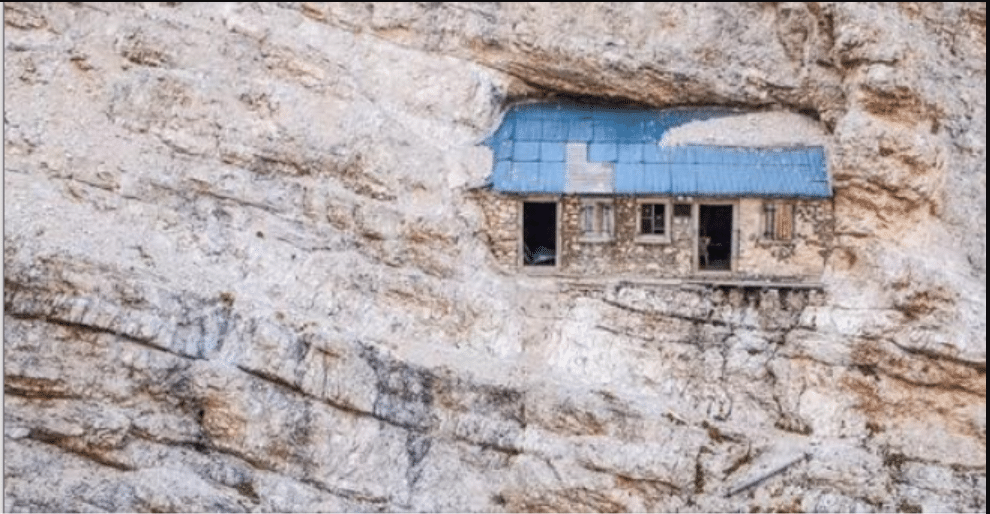The refuge is located on a ridge in the Monte Cristallo massif, which is part of the Ampezzo Dolomites Natural Park.
It’s thought that Italian troops built the shelter while fighting the Austro-Hungarians during WWI.
Hikers and climbers on the Via Ferrata Ivano Dibano will come across the shelter along the way.
To go to this incredible location, you’ll need a dash of bravery in your blood.
Amazing photos depict an abandoned Italian WWI refuge embedded in a vertical rockface in the Monte Cristallo massif of the Ampezzo Dolomites Natural Park.
There is no secret backdoor to it (that we know of). The shelter – which sits over 2,700m (8,858ft) above sea level – can only be accessed by negotiating challenging rocky ridges.
Today, the mountain range is part of the “Natural Park of the Ampezzo Dolomites,” but back during WWI, it was a scene of intense warfare between Italy and Austria-Hungary.
The warring sides installed heavy artillery, built tunnels under each other’s positions and blew the tops off of mountains to trigger avalanches resulting in thousands of deaths. Today, you can hike through the galleries they mined through the rock. It’s equally amazing and terrifying.
The armies also built many bunkers and shelters like the one depicted here. Judging by their history and unique location in the almost vertical cliff, this building will definitely survive armageddon.

Pictured is an abandoned refuge from World War I embedded in the Monte Cristallo massif in Italy’s Dolomites.

The spectacular shelter sits over 2,700m (8,858ft) above sea level and can only be accessed by hikers and climbers.

Not for the faint of heart, it looks as though to step out of the shelter’s doorway is to tumble into the valley below
The incredible refuge has been built inside one of the peaks of the massif. It features brick walls, a slanted roof, two doorways, and four windows framed in wood. Some of the windows are shuttered. It’s hard to believe, but someone had to carry all those building materials up the side of the mountain, as there is no backdoor to an easier access route.
At a glance, it looks as though to step out of the shelter’s doorway is to plummet into the valley below.
Multiple refuges like the one on Monte Cristallo were built during the armed conflict between the Italians and Austro-Hungarians known as The White War. Both sides pummeled the Dolomites with artillery, triggering avalanches and hunting the enemy from afar. They used rope ladders and cableways to access hard-to-reach locations like the one of this very shelter, to stock supplies and hide from the enemy and the merciless natural elements.
On May 23, 1915, Italy declared war on Austria-Hungary. A merciless battle ensued between Italy and the Austro-Hungarian forces in the Dolomites.

Although it looks impossible to reach, a narrow mountain trail passes right by Buffa di Perrero shelter, a few meters below. It’s part of the Via Ferrata Ivano Dibona, a difficult mountain trail that requires a “high level of fitness” and mountain climbing experience.

A Via Ferrata – Italian for ‘iron path’ – is a mountain route made up of steel ladders, rungs, and cables built into the rock to help climbers traverse difficult sections and reach remote locations.

If you’re wondering what the inside of this isolated mountain shelter looks like, well, it’s nothing special. It’s just a narrow space lined with wood and featuring a bunch of wooden chairs. It’s not where I’d choose to spend a night if I had a choice, but the people who built this place didn’t really have one.

If you’re wondering what the inside of this isolated mountain shelter looks like, well, it’s nothing special. It’s just a narrow space lined with wood and featuring a bunch of wooden chairs. It’s not where I’d choose to spend a night if I had a choice, but the people who built this place didn’t really have one.
The Via Ferrata Ivano Dibona starts from Cortina d’Ampezzo, a ski resort and town on the Boite river. The trail ‘calls for a high level of fitness’, according to Cortina Dolomiti, which adds that Monte Cristallo ‘still preserves the marks left by the Great War’.
Experienced climbers access the refuge by climbing up to the ridge below it. Many take photographs when they reach the shelter, sitting on the ledge of the doorway or standing inside.

Pictured are hikers climbing Monte Cristallo, which features on the Via Ferrata Ivano Dibona
Climbers cross the suspension bridge on the Via Ferrata Ivano Dibona. The Guido Lorenzi mountain hut can be seen in the background
One TripAdvisor reviewer who travelled along the Via Ferrata Ivano Dibona said: ‘It takes about six to eight hours with some awesome views and just amazing history, with buildings built into the rock wall.’
Elsewhere along the via Ferrata, climbers cross the Ponte Cristallo suspension bridge, which is 27m (89ft) long. Sylvester Stallone raced across the same bridge in the 1993 action film Cliffhanger when escaping a bomb blast.
The bridge leads to the photogenic Guido Lorenzi mountain hut, which is perched atop a mountain pass.

Pictured is another shelter built into a mountain in the Dolomites, which were declared a Unesco World Heritage Site in 2009
There are several other wartime shelters to discover along such routes in the Dolomites, which were declared a Unesco World Heritage Site in 2009.
In recent years, with the melting of glaciers and ice in the Dolomites, the nearby Ortles-Cevedale Alps, and the Adamello-Presanella Alps, relics from The White War, have begun to emerge in the thaw.
Earlier this year, on Mount Scorluzzo in Lombardy, a lost World War I mountain camp thawed out, revealing clothes, postcards, and canned food that belonged to the troops.
The conflict, which ended on the Italian front on November 4, 1918, claimed the lives of over 600,000 Italians and 400,000 Austro-Hungarians.









